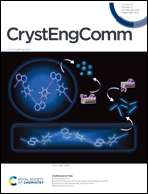Solid state structure and properties of phenyl diketopyrrolopyrrole derivatives†
Abstract
The solid state supramolecular interactions of diketopyrrolopyrrole derivatives (DPPs) and their correlation with thin film optical properties are of particular interest because of the applications of these materials in organic electronics. In this study, we report the single crystal X-ray structures of several phenyl DPP derivatives, containing 4-methoxyphenyl, 4-hydroxyphenyl and 4-((tetrahydro-2H-pyran-2-yl)oxy)phenyl aryl units, and show how subtle changes in the substituent chains at side or end positions of the chromophore can lead to very different packing. They are compared to their phenyl counterpart to explore how the nature of both the alkyl chain and the aryl unit influence the optical properties that have been measured in solid and solution states. Importantly, for the three families of N-substituted compounds studied, the structures are changed by the conformation of the molecules and are apparently dominated by crystal packing effects where edge-to-face interactions are favoured rather than π stacking, with only one of the compounds showing a flat form, promoted by intermolecular contacts between the aromatic regions. It is therefore possible that the twist between DPP and phenyl units in crystals of DPPs results from edge-to-face interactions (rather than steric interactions between the N-substituent and the protons attached to the aromatic ring) that might be overcome in more extended structures. Hydrogen bonding dominates the packing to generate chains of DPP units for phenol derivatives. Remote bulky groups do affect the core conformation. The emission of the materials as thin films is dominated by local effects in the packing of the materials that are unique for each case as the structures are distinct from one another. Charge mobility (as calculated from the crystal structures) is not favoured because of twisted conformations and large displacement, but the sometimes high emission and large Stokes shift could make the materials interesting for other purposes, such as light emitters.

- This article is part of the themed collection: Supramolecular & Polymorphism


 Please wait while we load your content...
Please wait while we load your content...